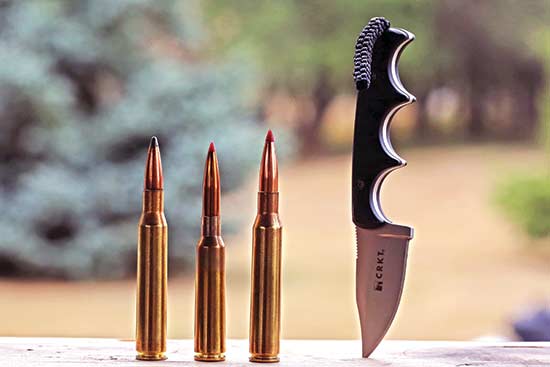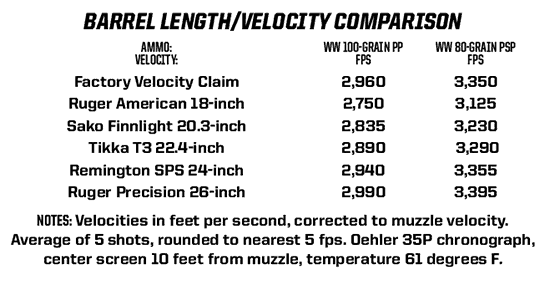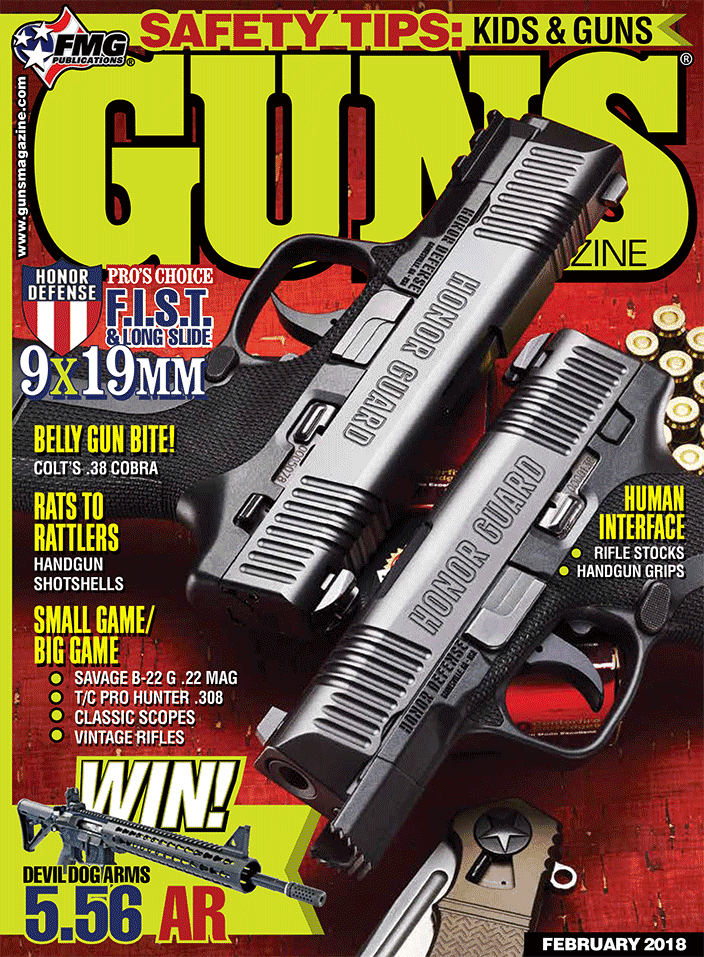Tried And True
New Technology Can Breathe New Life Into Your Old Rifles
On an inspection tour of the gun room recently, checking to see all was well and no rust gremlins had managed to sneak in, it suddenly struck me I’ve been neglecting some old friends. Rifles I had once considered pretty much perfect, veterans of many a fine hunt, stood forlorn on the racks, unfired in years.
Rifle, scope, and bullet technology has evolved over the past few decades. Taken year by year the changes don’t seem particularly dramatic. Cumulatively, over decades, they add up to a point where, as hunting tools, rifles have become considerably more efficient and effective.
None of which means old reliables are obsolescent. There are many riflemen who may find the latest and greatest mildly interesting but have no interest whatever in retiring a trusted friend. Cartridges such as 6mm and 6.5mm Creedmoor and .338 Lapua have advantages for longer range shooting, but for hunting, the old ’06 and .270 continue to work just fine.
Nonetheless, innovations and technology proven in competition can be applied to hunting rifles. Modern technology can increase their performance and efficiency, sometimes at minimal cost.
So what innovations are we talking about? The easiest way to explain is to compare old favorites with my current deer and antelope rifles.
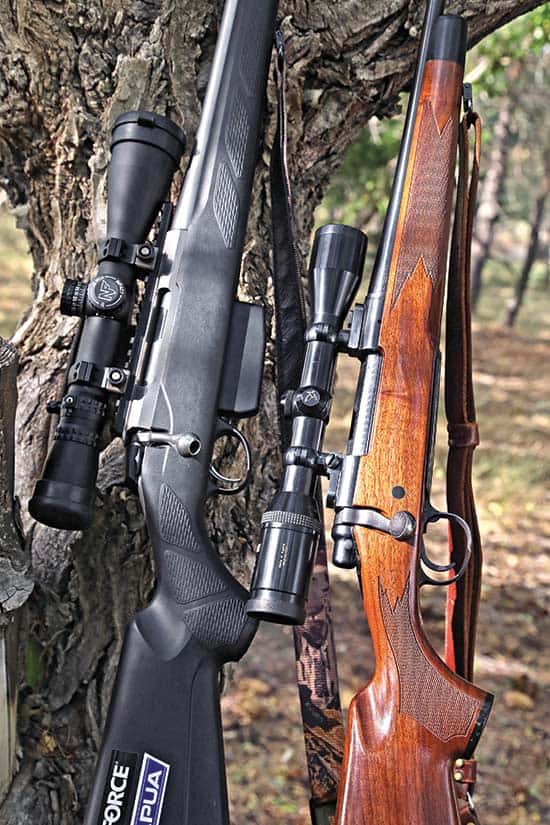
Dave’s new (sort of) Tikka T3 Stainless Lite in 6.5x55 Swedish Mauser is otherwise
quite modern sporting stainless steel barrel and action, synthetic stock, Talley 20 MOA
rail and Nightforce NXS 2.5-10x42 scope. His Remington 700 Mountain Rifle in .280 Rem,
now approaching 40 years of age, is blued steel with walnut stock, windage adjustable
bases/rings and Swarovski 3-9x36A scope. The rifles are nearly identical in size and weight,
but the Tikka is a bit heavier due to the heavier scope and rings
Old Friends
A couple of special favorites are from the early 1980s—a Winchester 70 Featherweight .270 Win and a Remington 700 Mountain Rifle in .280 Rem. For about 25 years I liked these two best for hunting mule deer and antelope in big open country. They carry a lot of good memories.
The Remington 700 .280 I consider my lucky mule deer rifle, mainly because we always seem to see lots of deer when hunting with it. More recently I’ve hunted mule deer with a Tikka T3 6.5×55. Comparing features side by side (see chart) the two rifles are similar in barrel length, overall length, and weight.
The obvious differences are in materials, walnut and blued carbon steel on the Remington vs. synthetic and stainless steel of the Tikka. Some of the less obvious differences are in the accessories. The .280 Mountain Rifle has a Swarovski 3-9×36, a scope with 1-inch tube and a simple thick/thin reticle. It’s a discontinued model, bought in the mid-’90s as I recall. Optics are excellent and it has held zero reliably.
The windage-style bases and rings are from the ’80s and were considered state of the art. I haven’t used this style in decades, mainly because the rear base/ring doesn’t have a lot of holding power. I don’t need windage adjustments in the base. I do need the rifle/scope attachment to be rock solid.
Back then it would never have occurred to me to dial elevation or windage adjustments in the field. All I asked of the adjustments was to allow sighting in at 200 or 250 yards, and then never move again. Flat-shooting cartridges such as the .270 and .280 would keep the bullet within 3 inches above or below line of sight out to 260 or 275 yards, depending on the load.
Holding the horizontal crosswire just below the backbone would result in solid hits to 300 yards and a bit more. If the game looked farther away (and it was hard to tell as we had no reliable, portable rangefinders at the time) the best policy was to get closer.
The Tikka T3 with its stainless/synthetic construction is less affected by changes in humidity, or by rain or snow. The Nightforce NXS 2.5-10×42 adjustments are reliable and accurate. The scope is attached to the rifle with heavy-duty rings and a Picatinny-style rail adding an extra 20 MOA inclination to make use of more of the scope’s elevation range.
For several years the load I used in the .280 was the 139-grain Hornady Spire Point loaded to a bit over 3,000 fps. Later I used other bullets from Barnes and Nosler as well, but the Hornady Interlocks always gave satisfactory results, plus my local dealer always had them in stock. The G1 ballistic coefficient is 0.392.
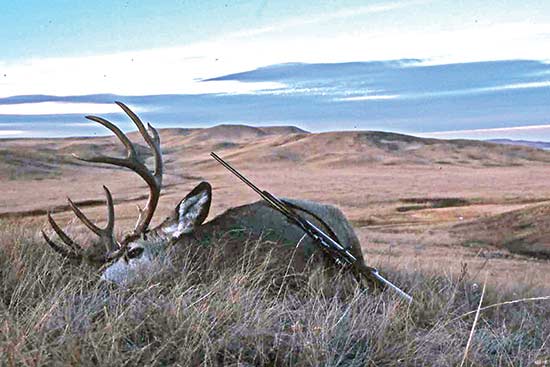
The Remington 700 Mountain Rifle .280 Rem is Dave’s favorite for hunting mule deer.
With it he’s taken six or seven bucks around this size, some smaller bucks and a few
does in antlerless seasons. This one was shot using the old-style 140-grain Barnes
coated bullets, called by some the “blue meanies.”
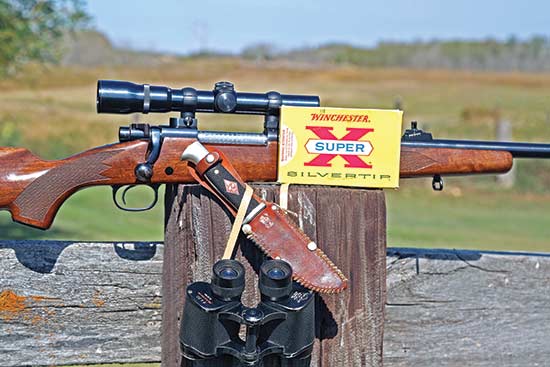
Dave shot his first mule deer in 1975 with this Winchester 70A .270 and factory W-W Silvertip
(likely from this very box since he seldom buys factory ammunition). The scope is a Weaver 1.5-4.5X
in windage adjustable bases/rings. A very accurate rifle, he once shot a 1-1/2-inch group at 300 yards
using Sierra bullets. Kind of a heavy old beast and as years went by it got used less and less. Binocular
and knife were Christmas presents when he was 11 and 12.<
Ups And Downs
In the Tikka 6.5×55 I’ve been loading the newer 143-grain Hornady ELD-X to 2,700 fps. This modern, super slick design has a G1 ballistic coefficient of 0.623. The chart shows how much we gain just by reshaping the bullet. The .280’s 139-grain bullet starts out 3,000 fps faster, but by 300 yards the advantage has dwindled to less than 30 fps. At farther ranges the 143 ELD-X is going faster.
The 139-grain bullet does shoot slightly flatter. With both zeroed at 200 yards the 139 drops about an inch less at 300 and 400 yards, 3 inches less at 500. I wouldn’t call this nothing, but elevation is the easiest factor to deal with—just read the range card and dial in the elevation.
But what really makes the ELD-X bullet superior is how it handles wind. In mule deer and antelope country there is always wind. We can have range cards showing wind drift and turret adjustments, maybe use a Kestrel weather station to read wind speed. Trouble is, the wind isn’t as predictable as the effects of gravity. Wind can change speed and direction a dozen times between the shooter and the target.
Look at the chart again, and see how just changing bullets reduces the effect of wind drift by about 30 percent. Thirty percent is a lot, and the best part is it doesn’t have to cost a thing. I can get the same benefits in my old .280 Rem. By loading the Hornady 150-grain ELD-X to 2,900 fps I can equal and even slightly surpass the performance of the 143 ELD-X in the 6.5×55.
Several major bulletmakers are adapting the streamlined features of their match bullets to hunting bullets. Why not just use the match bullets for hunting? Well, some people do, and if I believe what I read on the Internet they invariably get 1-shot kills at ranges from 20 yards to 800, although many makers recommend match bullets not be used on game. If they won’t believe the people who made the bullet then they aren’t going to believe me!
Old favorites don’t necessarily have to die. Dave’s old Remington 700 Mountain Rifle in .280 Rem with 139-grain Hornady Spire Point (left) put plenty of game in the freezer. Currently his Tikka in 6.5×55 shooting the 143-grain Hornady ELD-X has done equally as well. Now, the 700 .280 Rem shooting the 150-grain Hornady ELD-X is proving an even better performer. The 6.5×55 load starts out 300 fps slower than the 139 from the .280, goes faster at 400 yards while less affected by wind at all ranges. The 150 ELD-X loaded in the .280, however, resists wind just as well as the 143 and shoots a bit flatter.
Some combinations I’ve been using are .270, .280 and 7×57 Mauser cartridges, loaded with long-range hunting bullets from Barnes, Berger, Nosler and Hornady. Another series of bullets I look forward to trying are the Tipped Match Kings from Sierra.
Although I’ve fired many Berger bullets at targets I can’t recall using them for hunting. I do recall running into African Professional Hunter Errol Lambrechts at the SHOT Show one year. Like every PH I know Errol is fussy about the bullets his clients use. Show up with Barnes, Nosler Partition, Swift A-Frame, or other controlled-expansion bullet and Errol will be very happy.
On this occasion Errol told me he was adding Berger hunting bullets to his approved list, after a client using them ran of a string of 20+ 1-shot kills with a 7mm-08 Rem. “Although mind you, he was the best game shot I’ve ever had as a client,” Errol said.
“Ahem.”
“Other than you, of course.”
“Of course.”
The long, ballistically efficient bullets go particularly well with classic cartridges such as the 6.5×55 and 7×57 Mauser in long (i.e., 30-06 length) actions. It’s the same principle as the 6mm and 6.5mm Creedmoor in short actions. The Creedmoor cases are slightly shorter than the .308-based equivalents, the .243 Win and .260 Rem. The shorter case lets long bullets be seated out to fit 2.8-inch magazines without intruding into case capacity.
The 55 to 57mm length cases provide the same advantage with .30-06 length actions and magazines. This is hardly breaking news. Match shooters have been using long actions with 6.5-.284 and .284 cartridges for years. But I think it is very cool how well the newest bullet designs work with 19th century cartridges such as the 6.5×55 and 7×57. With new bullets, I can happily put many of my old friends back in the rotation.
